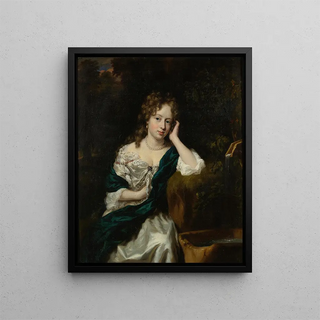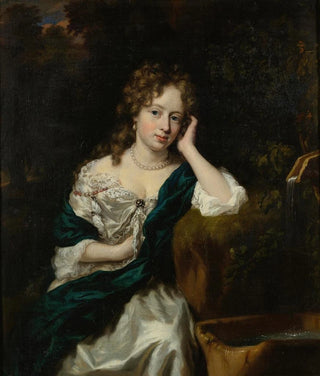Art print | Portrait of a seated lady near a fountain - Nicolaes Maes


View from behind

Frame (optional)
In the world of art, some works manage to transcend time and capture the very essence of humanity. The "Portrait of a Lady Sitting Near a Fountain" by Nicolaes Maes is a perfect example. This piece, imbued with delicacy and mystery, invites us to delve into a universe where every detail tells a story. The lady, frozen in a moment of contemplation, seems to address us, prompting us to question her identity, her thoughts, and the feelings that inhabit her. The art print of this masterpiece allows for a rediscovery of the beauty of 17th-century portraits, while offering a window into the intimacy of a moment frozen in time.
Style and uniqueness of the work
Nicolaes Maes's style is distinguished by his ability to capture light and the atmosphere of a moment. In this piece, the softness of the colors and the finesse of the protagonist's features create a captivating visual harmony. The lady, dressed in an elegant gown, is placed near a fountain, an element that evokes both serenity and the fluidity of time. The reflections in the water, the play of light on her face, and the meticulous details of her environment demonstrate remarkable technical mastery. Maes manages to infuse his subject with palpable life, an almost tangible quality that makes this portrait an essential piece of artistic heritage.
The artist and his influence
Nicolaes Maes, born in Dordrecht in 1634, is one of the masters of Dutch portraiture. A pupil of Rembrandt, he mastered his mentor's techniques while developing a distinctive style that is characteristic of him. His career, marked by a shift towards more intimate themes, testifies to a unique artistic sensitivity. Maes's portraits do not merely depict figures; they capture emotions, atmospheres, and personal stories. His influence extends beyond his era, inspiring many artists who seek to explore the psychological depth of their subjects. Through his works, Maes established a bridge between tradition and innovation, paving the way for new explorations in the

Matte finish

View from behind

Frame (optional)
In the world of art, some works manage to transcend time and capture the very essence of humanity. The "Portrait of a Lady Sitting Near a Fountain" by Nicolaes Maes is a perfect example. This piece, imbued with delicacy and mystery, invites us to delve into a universe where every detail tells a story. The lady, frozen in a moment of contemplation, seems to address us, prompting us to question her identity, her thoughts, and the feelings that inhabit her. The art print of this masterpiece allows for a rediscovery of the beauty of 17th-century portraits, while offering a window into the intimacy of a moment frozen in time.
Style and uniqueness of the work
Nicolaes Maes's style is distinguished by his ability to capture light and the atmosphere of a moment. In this piece, the softness of the colors and the finesse of the protagonist's features create a captivating visual harmony. The lady, dressed in an elegant gown, is placed near a fountain, an element that evokes both serenity and the fluidity of time. The reflections in the water, the play of light on her face, and the meticulous details of her environment demonstrate remarkable technical mastery. Maes manages to infuse his subject with palpable life, an almost tangible quality that makes this portrait an essential piece of artistic heritage.
The artist and his influence
Nicolaes Maes, born in Dordrecht in 1634, is one of the masters of Dutch portraiture. A pupil of Rembrandt, he mastered his mentor's techniques while developing a distinctive style that is characteristic of him. His career, marked by a shift towards more intimate themes, testifies to a unique artistic sensitivity. Maes's portraits do not merely depict figures; they capture emotions, atmospheres, and personal stories. His influence extends beyond his era, inspiring many artists who seek to explore the psychological depth of their subjects. Through his works, Maes established a bridge between tradition and innovation, paving the way for new explorations in the






